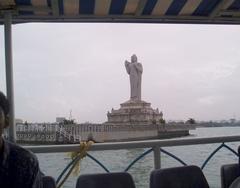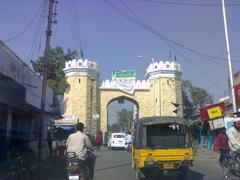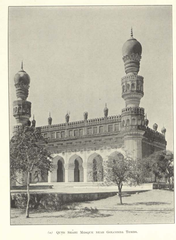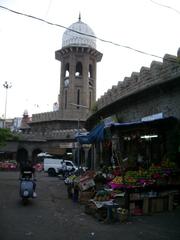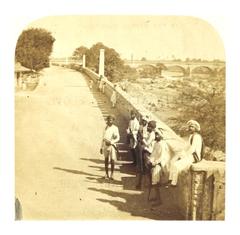
Karmanghat Hanuman Temple: Visiting Hours, Tickets, and Historical Significance in Hyderabad
Date: 03/07/2025
Introduction
Nestled in Hyderabad, the Karmanghat Hanuman Temple stands as a testament to centuries of devotion, architectural splendor, and cultural resilience. Established in the late 12th century CE during the Kakatiya dynasty, this temple not only draws thousands of devotees but also attracts history enthusiasts and travelers with its legendary origins, distinctive meditative Hanuman idol, and enduring spiritual aura. This guide details the temple’s history, architecture, spiritual significance, visitor information, and travel tips, ensuring a well-informed and enriching visit to one of Hyderabad’s most iconic sites.
Historical Background
Origins and Foundation
The temple’s origins date back to the reign of the Kakatiya dynasty—specifically, King Prola II or Prataprudra II, around 1198 CE. According to legend, while on a hunting expedition, the king was drawn to the chanting of Lord Rama’s name emanating from a stone idol of Hanuman in a meditative posture. After experiencing a divine vision instructing him to build a temple at the site, the king established the Karmanghat Hanuman Temple, setting the foundation for its spiritual and historical legacy (Wikipedia; TemplePurohit; Viharadarshani).
Etymology and Significant Legend
The name “Karmanghat” is tied to a dramatic episode during the Mughal era, involving Emperor Aurangzeb. When attempts were made to demolish the temple, a celestial voice thundered, “Mandir todna hai, rajan, karo man ghat” (“If you wish to break the temple, harden your heart, O King”), halting the destruction and giving the temple and locality their name (TFIGlobalNews; TemplePurohit).
Architectural Evolution
The temple has undergone several renovations, blending Dravidian and Rajasthani styles. The main sanctum houses Hanuman in a unique meditative posture (Dhyana Anjaneya), surrounded by intricately carved pillars and subsidiary shrines dedicated to deities such as Rama, Shiva, Saraswati, Durga, and Jagannath, reflecting the inclusive spirit of Hindu worship (IndiaTourismGuide; Wikipedia).
Historical Significance
Throughout its existence, the temple has survived invasions and political upheaval, continuing to be a focal point for major Hindu festivals like Hanuman Jayanti and Sri Rama Navami, and serving as a center for cultural transmission across generations (OurTemplesInc; TemplePurohit).
Spiritual Legacy and Religious Importance
Hanuman as Divine Protector
The temple venerates Hanuman as Dhyana Anjaneya Swamy—embodying strength and devotion. The faithful believe in Hanuman’s protective powers, seeking courage, relief from obstacles, and blessings at this sacred site (Dharmlok, 2023).
Miraculous Legends
The temple’s miraculous survival during Aurangzeb’s campaign underlines its reputation as a symbol of divine protection and unwavering faith (Dharmlok, 2023).
Multi-Deity Worship and Rituals
Along with Hanuman, shrines for Rama, Shiva, Saraswati, Durga, Santoshimata, Venugopala Swamy, and Jagannath enable devotees to participate in diverse rituals and festivals, especially on Tuesdays and Saturdays—days traditionally dedicated to Hanuman (Dharmlok, 2023).
Architectural Features
Layout and Design
The temple covers approximately three acres, featuring a central sanctum facing east, surrounded by subsidiary shrines, a sacred pond for ritual purification, spacious mandapas, and a grand gopuram adorned with intricate carvings (Indian Eagle; OmAstrology).
Iconography and Artistic Details
Carvings throughout the temple illustrate episodes from the Ramayana and Mahabharata, while floral and geometric motifs accentuate the spiritual ambiance (Poojn.in).
Community and Ritual Spaces
Facilities include an Annadanam hall providing free meals, ritual spaces for pujas and vehicle blessings, and accessible pathways for elderly and differently-abled devotees (Mandir Timings).
Lighting and Maintenance
Natural daylight is complemented by oil lamps and electric lighting during festivals, contributing to a serene atmosphere. The temple is regularly maintained and renovated to preserve its historical features (Temple Origins).
Visitor Information
Visiting Hours
- General: 6:00 AM – 12:00 PM and 4:00 PM – 8:00 PM (timings may extend during festivals).
- Special Note: Tuesdays and Saturdays are peak days for Hanuman worship.
Entry and Tickets
- Entry Fee: Free for all visitors. Voluntary donations are welcomed.
Accessibility
- Wheelchair ramps and wide pathways are available. Some older sections have steps; assistance is provided upon request.
Dress Code and Etiquette
- Modest clothing is recommended (preferably traditional attire).
- Footwear must be removed before entry.
- Photography is permitted in most areas but restricted inside the main sanctum.
Facilities
- Footwear stands, drinking water, restrooms, and vendors for flowers and prasad are available.
- Annadanam (free meals) is served during special occasions.
Safety and Security
- Security staff are present during operating hours.
- Lost and found services are handled at the temple office.
Getting There
By Public Transport
- Bus: Several city bus routes stop at Manda Mallamma, near the temple (Moovit).
- Metro: LB Nagar Metro Station is about 5 km away; take an auto or taxi from there.
By Private Vehicle
- Ample parking is available, but spaces fill quickly on festival days.
- Ride-hailing apps like Ola and Uber provide convenient access.
From Major Landmarks
- Rajiv Gandhi International Airport: 25 km (~45 minutes by car)
- Secunderabad Railway Station: 17 km (~35–45 minutes by car)
- LB Nagar Metro Station: 5 km (~10–15 minutes by auto/taxi)
(Poojn.in)
Special Events and Festivals
Major Hindu festivals celebrated at the temple include:
- Hanuman Jayanti
- Sri Rama Navami
- Maha Shivaratri
These events feature special poojas, cultural programs, and community feasts, attracting large crowds and offering a vibrant cultural experience.
Nearby Attractions
Combine your temple visit with other Hyderabad highlights:
- Charminar (historic monument)
- Golconda Fort
- Qutb Shahi Tombs
- Santosh Nagar markets and eateries
Visual Gallery
(Alt text is optimized for accessibility and SEO.)
Frequently Asked Questions (FAQ)
Q: What are the visiting hours?
A: 6:00 AM – 12:00 PM and 4:00 PM – 8:00 PM daily.
Q: Is there an entry fee?
A: No, entry is free. Donations are welcome.
Q: Are guided tours available?
A: Yes, on request via the temple office or local tourism agencies.
Q: Is the temple wheelchair accessible?
A: Yes, with ramps and assistance available.
Q: Can I take photographs?
A: Yes, except inside the main sanctum.
Q: When is the best time to visit?
A: Weekdays for less crowd, or during festivals for cultural vibrancy.
Essential Tips for Visitors
- Visit early mornings or late afternoons for a serene experience.
- Use public transport during festivals to avoid parking shortages.
- Dress modestly and respect temple customs.
- Carry some change for donations and purchases.
- Use navigation apps like Moovit or Google Maps for real-time travel updates.
Conclusion
The Karmanghat Hanuman Temple is not just a spiritual retreat but a living chronicle of Hyderabad’s religious, cultural, and architectural legacy. Its unique blend of history, legend, and ongoing community service makes it an essential stop for anyone exploring the city’s heritage. Plan your visit using this guide, experience the temple’s tranquil ambiance, and connect with centuries-old traditions.
For detailed maps, audio guides, and real-time updates, download the Audiala app. Stay tuned to our platform for more guides on Hyderabad’s historical and spiritual landmarks.
References and Useful Links
- Karmanghat Hanuman Temple - Wikipedia
- Hyderabad’s Karmanghat Hanuman Temple: A Light of Divine Grace - Dharmlok
- Karmanghat Hanuman Temple - TemplePurohit
- Karmanghat Hanuman Temple - IndiaTourismGuide
- Karmanghat Hanuman Temple History and Travel Guide - TFIGlobalNews
- Exploring the Best Temples in Hyderabad - OurTemplesInc
- Karmanghat Hanuman Temple in Hyderabad - Indian Eagle
- Karmanghat Hanuman Temple - Hyderabad Tourism
- Karmanghat Hanuman Temple Transportation Guide - Poojn.in
- Public Transit to Karmanghat Hanuman Temple - Moovit
- Karmanghat Hanuman Temple Complete Guide - OmAstrology
- Karmanghat Hanuman Temple Timings - Mandir Timings

